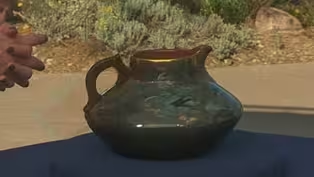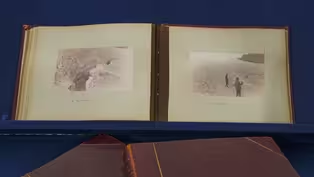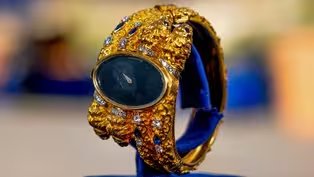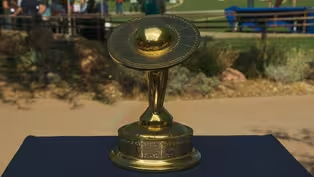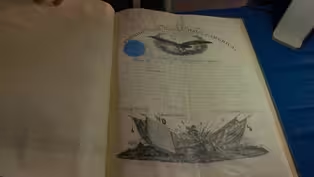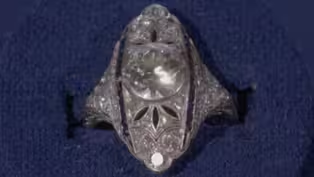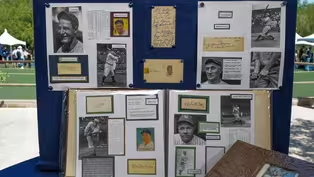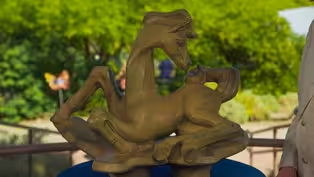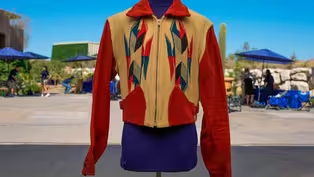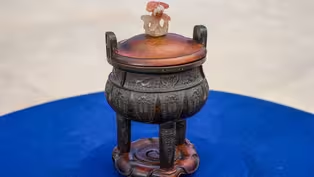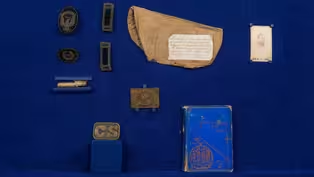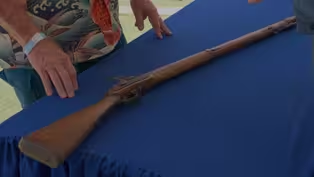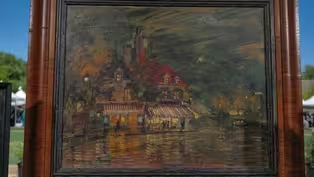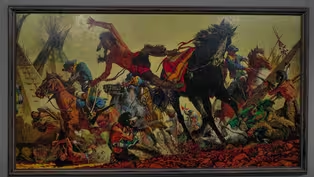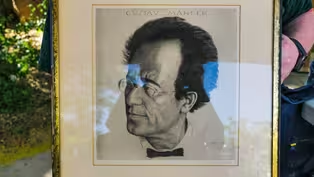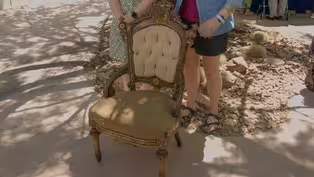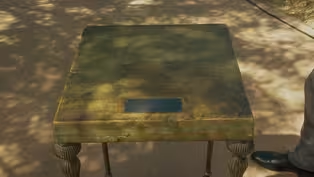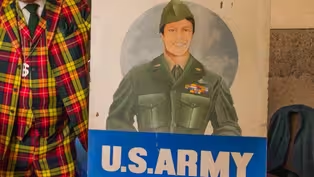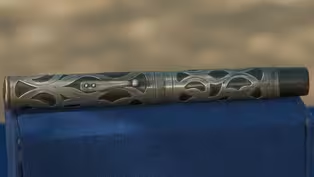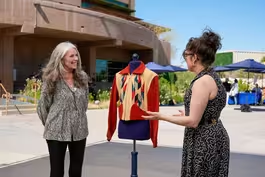
Springs Preserve, Hour 3
Season 29 Episode 6 | 52m 25sVideo has Closed Captions
ROADSHOW heads to the Mojave Desert in search of marvels at Springs Preserve in Las Vegas.
ROADSHOW heads to the Mojave Desert in search of marvels at Springs Preserve. Finds include a Frank McCarthy oil painting, baseball autographs, ca. 1945 and a 1977 Elvis Presley watch presented to Redd Foxx. One is $80,000 to $120,000!
Problems playing video? | Closed Captioning Feedback
Problems playing video? | Closed Captioning Feedback
Funding for ANTIQUES ROADSHOW is provided by Ancestry and American Cruise Lines. Additional funding is provided by public television viewers.

Springs Preserve, Hour 3
Season 29 Episode 6 | 52m 25sVideo has Closed Captions
ROADSHOW heads to the Mojave Desert in search of marvels at Springs Preserve. Finds include a Frank McCarthy oil painting, baseball autographs, ca. 1945 and a 1977 Elvis Presley watch presented to Redd Foxx. One is $80,000 to $120,000!
Problems playing video? | Closed Captioning Feedback
How to Watch Antiques Roadshow
Antiques Roadshow is available to stream on pbs.org and the free PBS App, available on iPhone, Apple TV, Android TV, Android smartphones, Amazon Fire TV, Amazon Fire Tablet, Roku, Samsung Smart TV, and Vizio.
Buy Now
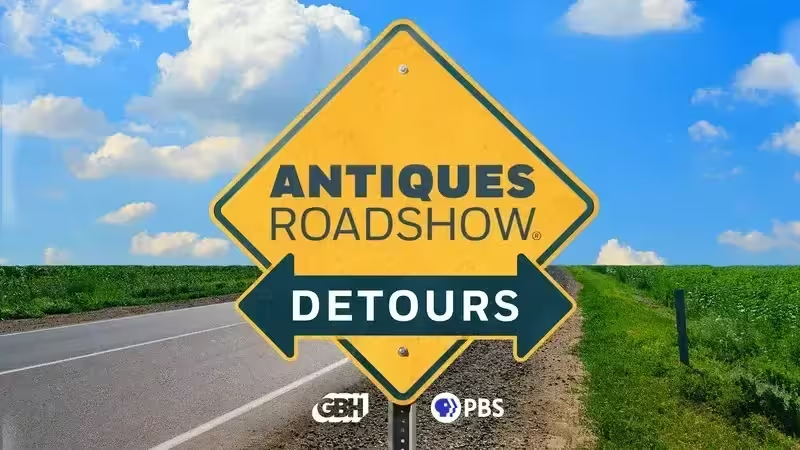
ANTIQUES ROADSHOW DETOURS
Ever wondered what happens to the treasures featured on America’s beloved ANTIQUES ROADSHOW after the cameras leave town? Host Adam Monahan tracks down the juicy afterlives of your favorite finds from PBS’s hit series.Providing Support for PBS.org
Learn Moreabout PBS online sponsorship♪ ♪ CORAL PE: "Antiques Roadshow" is seeing the marvels of the Mojave Desert at Springs Preserve in Las Vegas.
This is what I call compound provenance.
When you have one famous person giving something to another famous person.
It, it's a really fabulous chair.
Awesome.
(chuckles) ♪ ♪ PE: Springs Preserve is a 180-acre attraction away from the spectacle and glitz of the Strip.
A place that explores the history of Nevada as well as its nature and wildlife.
as well as its nature and wildlife.
Springs Preserve opened in 2007 on the site of the original springs that decades ago was the main water supply for the young city of Las Vegas.
The site offers museums, historic buildings, and trails.
historic buildings, and trails.
And today, thousands of artworks and collectibles from all over the Southwest have been carried in to be scrutinized by "Roadshow" experts.
Take a look.
GUEST: About ten years ago, I found this at a Goodwill.
Unfortunately, there were a couple of guys that got ahead of me and they took the frame and-and ripped that off, but they left the painting.
I fell in love with the art.
The other things that I bought with this painting that day, I think it totaled $20.
GUEST: This is a 1984 Keith Haring print.
This is from Andy Warhol magazine, "Interview" magazine.
This is actually in the inside of the magazine.
I think I paid $15.
GUEST: Well, this was my husband's grandparents'.
(chuckling): We don't exactly know a lot about it other than there was a little piece of paper in it that said "Old."
That's it.
(chuckles) Pieces of Rookwood are not coming into "Roadshow" as much as they used to.
This would have been one of their earliest series.
This is done in 1883.
The company started in 1880, it was in Cincinnati, Ohio.
The company started in 1880, it was in Cincinnati, Ohio.
This line was referred to as Limoges or Limoges-style.
This line was referred to as Limoges or Limoges-style.
Limoges is a city outside of Paris that was a huge center for mostly porcelain.
that was a huge center for mostly porcelain.
The French makers would have been shown at the Centennial Exposition in Philadelphia in 1876.
And the women who ended up starting Rookwood Pottery and the American art pottery movement Rookwood Pottery and the American art pottery movement in general, would all have been at that exhibition.
in general, would all have been at that exhibition.
And they would have been impressed to see how the Japanese aesthetic was being interpreted by the French.
We have bamboo and swallows in flight, We have bamboo and swallows in flight, which almost look like bats.
And clouds, which form like a veil.
It's a really sweet piece.
There's something early and a little clumsy about it.
There's something early and a little clumsy about it.
This is earthenware.
We have the mark of Rookwood Pottery, and we have a date of 1883. and we have a date of 1883.
This may be the name of the artist, but it's very hard to decipher.
Oh.
So it could have been one of several people doing this, including the founder of Rookwood Pottery, who was a woman...
Okay.
...and who did this on her own, Maria Longworth Nichols.
It's an important piece.
Any collection, including any museum collection that has any depth in the American art pottery movement, that has any depth in the American art pottery movement, has to have a piece of this.
Wow.
(laughs) Okay, this is in all the best American museums.
Wow.
(laughs) Okay, this is in all the best American museums.
Wow!
(laughs) That's great, that... (laughs) A pre-auction estimate these days would probably be A pre-auction estimate these days would probably be $1,000 to $1,500.
(laughing): Wow, I was thinking like $200!
(laughing): Wow, I was thinking like $200!
That's great.
I love it.
It's not as popular as it would have been... Yeah.
...20 and 30 and 40 years ago.
But it is a really important piece of America.
But it is a really important piece of America.
Well, that's great.
Thank you so much.
My pleasure.
Yay!
I'm very happy.
GUEST: This Chinese urn, I-- it's been in our family for over 110 years.
It was given to my great-grandfather, he was a prominent figure in Chicago, by a missionary.
Inside the bowl here, there's a pi-- there's a piece of paper in there.
And it says "Old Ming Dynasty, 300 years old."
And it says "Old Ming Dynasty, 300 years old."
And it's dated on the back of it 1910.
We can find on the inside... Uh-huh.
...this is the label, as you mentioned.
"Old Bronze, 300 years old, Ming Dynasty."
This doesn't date from the Ming Dynasty, though.
The mark is here on the base.
The mark is here on the base.
And it turns out that in the 19th century, And it turns out that in the 19th century, 1843, exactly, there was a very famous vessel, famous at its time... there was a very famous vessel, famous at its time... Hm.
...unearthed and discovered in China, that was attributable to a famous duke during a period that goes all the way back to the Western Zhou dynasty.
Okay.
And so this was a very celebrated, Okay.
And so this was a very celebrated, rare find in its day.
What this bronze is, I believe, a... an 1843, circa, copy a... an 1843, circa, copy in the style of that ancient bronze.
I see.
It's called a ding vessel.
Back in ancient China, this was used for ritual purpose.
Okay.
They would put food offerings, wine offering.
When this was made during the Qing Dynasty, it would have been used, if used at all, to burn incense.
It would have been used as a censer.
Probably why it's a little charred in there or whatever.
They would put sand in here... Uh-huh.
Oh, I see.
and then put incense sticks in it.
Oh.
This was combined with the base and the cover that we see.
Now, how do I know the cover is later?
Okay.
Well, as a censer, a cover like this would have never been made for something that needs to be vented.
There's no vent in this cover at all.
Oh, I see, I see.
So it was made... Huh.
...it was sort of converted into a purely decorative object.
I would say that in terms of what this would have cost at the time, the bronze is of, is of high quality.
It's hefty, I think it would have been outside the means of anyone but a very high ranking scholar or official...
Okay.
...to be able to afford something of this type.
Is this jade or is it, uh...?
This is carnelian.
Carnelian.
Oh, oh okay.
This is a variety of agate called carnelian.
Ooh.
I thought it was teakwood.
Is-is any idea what the wood is?
This is a variety of rosewood.
Rosewood.
And this rosewood is-is what we call hongmu.
And hongmu is a, is a tree that grows in southern China.
Mm-hmm.
Do you have any idea of its value?
I would just put something like $3,000, $4,000 on it.
I think you're a little on the conservative side.
Yeah?
If this were from the Ming Dynasty, it would not be substantially more money.
Oh, okay.
I think it's more interesting historically, culturally, and I think even value-wise that it evokes that specific period... Uh-huh.
...when a-a great discovery was made.
I think if this were to come to auction today, I'm on the conservative side, go in with an estimate of $5,000 to $8,000.
Okay.
All right.
I think it's a terrific bronze.
Very desirable in the market right now.
All right, well, sounds pretty good.
I always wondered about it.
I've been looking after it 35 years.
GUEST: This is Alice, and I got Alice at an auction two years ago.
GUEST: This is Alice, and I got Alice at an auction two years ago.
I'm hoping to find out if she's the real deal or-or what.
But she's lovely, we love her.
She's probably 1920s.
She's probably 1920s.
GUEST: So I brought a print, a photograph from 1875, the graduating class at Princeton University.
And it's called a composite.
And that's where each man is individually photographed and then they're put together in a scene.
I got it at a garage sale.
I paid $60 for it.
And the woman I bought it from, she said her mother dated one of the guys in this photograph.
Gallagher?
After graduating from Princeton, the-the gentleman came out to California because of the gold rush.
So maybe that's how it made it to California, where I'm from.
where I'm from.
GUEST: We purchased it about 40 years ago at a small gallery GUEST: We purchased it about 40 years ago at a small gallery near our home in Lake Elsinore, California.
Just loved it.
I don't even think we paid $1,000 for it.
I don't even think we paid $1,000 for it.
But I know it's by Frank McCarthy, a very famous Western artist.
We love all this action.
Little vignettes everywhere.
It's easy to see why he was nicknamed the Dean of Western Action Painters.
This is what he specialized in.
What-what else do you know about him?
Well, it, uh, has to do with Chief Joseph, his surrender in 1877, a Nez Perce Indian.
his surrender in 1877, a Nez Perce Indian.
They were forced to surrender.
We had had the magazine at one time, "Argosy" magazine.
It had the picture in the magazine and a story concerning what was going on in the picture.
So that's how we knew.
He did do "Argosy" magazine, and also "Collier's" and "True," and alongside that, he did a lot of covers for the Western novels.
He was from New York, originally.
He always lived there, and-and also in Connecticut.
He was best known for doing illustration.
He studied commercial art, and so he did books.
He also did movies.
Yes.
So he did a couple of the James Bond movies...
Yes.
...like "Thunderball," and "You Only Live Twice."
That's right.
And one of my favorite action movies, "The Great Escape."
But 1973 was a real watershed year for him, because he had an exhibition of his art... Mm-hmm.
...and it sold out almost immediately.
Right.
And that gave him the impetus to move from New York to Arizona.
And that gave him the impetus to move from New York to Arizona.
And so he went from being an illustration artist to being thought of more as a Western artist.
So there's more the fine art aspect of it.
This is a oil on board.
You had mentioned that it was in "Argosy" magazine, and unfortunately, you've lost track of that now.
That would have been great in helping us to determine exactly when this was painted.
But given that it's one of his illustration pieces, I'm thinking it's probably in the '40s, '50s.
I think, and I spoke with my colleagues, we think, at auction, $12,000 to $18,000.
we think, at auction, $12,000 to $18,000.
Really?
Yeah, comfortably.
Guess I should get insurance.
(chuckles) Well, thank you.
I would suggest an insurance figure of $30,000.
Oh, really?
Yeah.
♪ ♪ NATHAN HARPER: When people visit Las Vegas, they often think that it just popped up in the middle of the desert out of nowhere.
A lot of people don't realize that Las Vegas is a railroad town.
Without the railroad, Las Vegas probably wouldn't ever be here.
And without the water from the springs, the railroad wouldn't have come here.
Boomtown 1905 is a reconstruction of what Las Vegas would have looked like in its earliest days as a railroad town.
The cottages that we've restored on that site are original cottages built by the San Pedro, Los Angeles and Salt lake Railroad between 1910 and 1911-- there were originally 64 of these cottages.
You could almost argue that it's one of the earliest housing developments, corporate housing developments, here in the West.
GUEST: My best friend is the third generation, I believe, GUEST: My best friend is the third generation, I believe, that this has been handed down to.
that this has been handed down to.
She wanted me to have it.
All of the family at that point had passed away.
When I read the book, I couldn't put it down.
It was mesmerizing.
Four generations back, George Bailey was known as the carriage man George Bailey was known as the carriage man in St. Louis, Missouri.
He made carriages in the early 1800s.
And this is his son.
He was captured by the Confederate Army.
They were being marched to Andersonville.
He asked several of the men that had been captured to bury him in the ground and cover him with limbs and bushes and leaves, and cover him with limbs and bushes and leaves, where he stayed in the ground, according to his book, for I think two days, He was breathing through a reed.
I think he heard the scouts go by, so he thought it was safe to get up.
He was shot twice.
He made his way close to Atlanta where he came upon some Union soldiers and they put him in the hospital.
That is quite a story.
Yeah, it's fascinating.
Well, he's a man from my home state, this is a Missourian.
That's true.
Which made it appeal to me.
The Union 6th Missouri was an incredibly hard fought unit.
This is the hat badge from the side of the Hardee hat.
This is from the front.
A couple of subdued infantry, lieutenant shoulder straps.
But the thing that really struck me about his service But the thing that really struck me about his service is he clearly had an eye for history.
The first thing that pointed that out to me is this cartridge, this little rolled up piece of paper here is a Confederate cartridge, on which he has written "Rebel cartridge.
on which he has written "Rebel cartridge.
Vicksburg, July 4, 1863."
Yes, he did.
Ju-July 4, 1863 is a big, big day for the Union.
Ju-July 4, 1863 is a big, big day for the Union.
That's when Vicksburg fell, and he had the presence of mind to realize that he was involved in something greater than himself.
Mm-hmm.
He also has a couple of other trophies.
We have a Port Hudson style or an Army of Tennessee style, depending on who you ask about it, Confederate belt plate.
Mm-hmm.
This one is from the state of Louisiana.
Mm-hmm.
This one is from the state of Louisiana.
Mm-hmm.
And then we get into this, Which you would look at and think, "That's a rag."
Right.
"What are we doing with that?"
He has recorded and told us why that's important.
He would, um, find his way to a plantation He would, um, find his way to a plantation or to someone's home out in, or to someone's home out in, I guess, the swampy areas, and they would hide him.
I guess, the swampy areas, and they would hide him.
They would give him food.
This was the enslaved people in that area?
Correct.
This was the enslaved people in that area?
Correct.
I guess when the war was over and he was out of the hospital and he had healed, he went back and visited some of those people.
he went back and visited some of those people.
It is my firm belief that the whole is greater than the sum of the parts.
But simply adding up the individual parts, together, that alone is $15,000 to $20,000.
Okay.
together, that alone is $15,000 to $20,000.
Okay.
But, as a collection, I think But, as a collection, I think $25,000 to $30,000 Okay, that's wonderful.
If you choose to insure it, I would make sure that you have an insurance policy on this that covers it for $35,000.
Okay.
GUEST: This is a lifetime achievement award to Leonard Nimoy.
GUEST: This is a lifetime achievement award to Leonard Nimoy.
He actually gave it to me.
APPRAISER: What was it like knowing the man, the myth, the legend (chuckling): that is Leonard Nimoy?
He was a very nice man.
He rented space from the company I worked for.
I worked in a cubicle and he had the office right behind me.
So he was 20 feet away, like, every day.
Interesting, that is so cool.
You are correct in that this is a lifetime achievement award.
But what this award is actually known as is a Saturn Award.
First awarded in 1973, these are given out by the Academy of Science Fiction, Fantasy, and Horror.
A Saturn Award might not be a big name like we hear, you know, Emmys, Golden Globe and Oscar.
But in the world of everything cool, pop culture, nerdy science fiction, a Saturn Award is a pretty big deal.
The Academy of Science Fiction, Fantasy, and Horror was first created by Donald Reed in 1972, and they still give out the Saturn Award today.
In 1986, Leonard Nimoy received this right here, the lifetime achievement award.
And when it comes to Leonard Nimoy as a actor, as a personality, his name is synonymous with the world of pop culture.
Obviously, everybody knows him from Spock on "Star Trek."
Obviously, everybody knows him from Spock on "Star Trek."
Spock was such an important character.
Everybody remembers that-- I'm gonna embarrass myself.
I don't know what it is, but I cannot do the Vulcan salute.
I know!
I don't have-- I don't know what it is.
I don't have these muscles.
(laughs) What do you think it's worth?
I have no clue as to what it's worth.
It almost doesn't matter because it's my connection to Leonard.
Gotcha.
I got to see this thing every day.
So when he closed his office down and his assistant asked if I wanted anything, knowing I was a Trekkie, I said, "You know, I look at this thing every day, can I have this?"
Not knowing what it was, I had no idea what it was.
I just knew it was a statue in his office.
(laughs) And she said, "Let me ask him."
So she went, she asked him, next thing I know, it's on my desk.
At auction for this award, today, at a pop culture entertainment memorabilia sale, we'd be able to conservatively estimate it $5,000 to $8,000.
we'd be able to conservatively estimate it $5,000 to $8,000.
Okay, time for insurance.
(laughing) Wow!
Based on the other Saturn Awards that have come up, I think this would be arguably one of the best to hit the market.
And I wouldn't be surprised if that high estimate was doubled in the $15,000-plus range.
Holy cr...
I won't say that, um.
(laughs) Wow, that's... ...okay, it's still going back to my house.
It's still going to go sit next to the TV, because we watch "Star Trek" every night.
I would not insure it for any less than $15,000 because you're not going to find another one.
It's truly one of a kind.
Oh, wow.
GUEST: This is a collection of postcards, kind of '60s rock posters from the San Francisco area mostly.
rock posters from the San Francisco area mostly.
Most of these exist in, like, a larger poster format, of course, but I-I just got a bunch of postcards here.
I paid $17 for these online.
I paid $17 for these online.
This is a ruffled plate celebrating the Bicentennial, 1776 to 1976. celebrating the Bicentennial, 1776 to 1976.
The U.S.
Bicentennial.
PRODUCER: How much did you have to pay?
$26 with shipping.
$26 with shipping.
I think it's my dad's from back World War II or something, it's... that's...
I don't, I don't know the whole story.
That's why I'm here.
Well, I brought in this, uh, Native American jacket Well, I brought in this, uh, Native American jacket that belonged to my mother.
My grandmother was born and raised on an Indian reservation in New Mexico.
I think it's, um, Navajo.
My heritage is Navajo, Pueblo, and Apache Indian.
My heritage is Navajo, Pueblo, and Apache Indian.
I found pretty much the same exact model... Oh.
...in mail order catalogs from about 1940, 1941.
...in mail order catalogs from about 1940, 1941.
This is what is known as a Chimayo jacket.
This is a very distinctive style of weaving, Chimayo weaving coming from the area, Chimayo, in northern New Mexico.
Two families are credited with having started this kind of Chimayo weaving: the Ortegas and the Trujillos.
They're usually these central single motifs that have diamonds, stripes.
In this case, there's also rhombus.
It's usually on a solid ground.
And you really get a sense on the back of that central, classic Chimayo motif.
This tradition picked up in the early 20th century.
And this is an object that was also sold basically as a souvenir.
As for the-the weaving, it would have been done in that area, in Chimayo, by women weavers.
A variety of companies were marketing these for the tourist trade, but also locals who were buying these objects, too.
I could see that there was a label in it at one time...
Yes.
...but it had been removed.
So we don't know which manufacturer this was.
What is interesting is that at the time that these are being marketed to tourist audiences, they're calling it Mexican work, not New Mexican.
So there's this conflation between cultures.
Not necessarily understanding that this is really specific to northern New Mexico.
You don't see it outside of this-this region, this kind of weaving; Chimayo weaving.
These are hand-loomed.
The fabric is all wool and then the sleeves are a cotton corduroy.
They sold in the range of about $8.00, $8.75, which in today's money is about $175.
Wasn't the cheapest object.
In a retail setting, because these are highly collectible, I think you could expect $1,500 to $2,500.
I think you could expect $1,500 to $2,500.
Oh, my gosh!
Oh, my!
I had no idea.
Amazing.
(chuckles) That's amazing.
Wow.
Incredible, well, I'm glad I held onto it.
As an insurance value, I would say, just to be safe, $3,000.
Okay, great.
$3,000.
Okay, great.
GUEST: This ring belonged to my grandmother and she passed away in 1981.
Before that time, she was quite a fancy lady.
Before that time, she was quite a fancy lady.
Loved to wear her rings and her blings.
Got her hair done every week, got her nails done and put her rings on and went out.
So when she passed away, I went through her closet.
And in the pockets of her jackets, I found this ring wrapped in a little piece of tissue.
She did not have a jewelry box, but she hid her rings and her jewelry in her closet on the clothes.
This ring was probably made in the 1920s.
Mm-hm.
And it's probably American.
Mm, okay.
Okay, and in the center, that-that nice stone is an old European-cut diamond.
The center stone is just under three carats by formula.
Around the ring, you have more old European-cut diamonds and some single-cut diamonds.
Ah!
And then you can see there are two lines here... Ah!
And then you can see there are two lines here... Mm-hm.
...of channel-set sapphires.
Wow, wow.
Now you can see someone definitely wore this ring... Mm-hmm.
...because some of the sapphires are missing.
Yes.
It's not a difficult repair.
Yes.
Yes.
Yes.
It really doesn't affect the value of the ring that much.
Above the stone on each side are these little tiny cutouts.
Yes, yeah, yeah.
So you're just kind of playing with that as well.
It c-- your eye keeps moving, there's all these details.
This is an incredible attention to craftsmanship.
Wow, wow.
And it's not marked at all, so we don't know who made it.
No.
I would insure this at $25,000.
$25,000, okay, wow.
Well, that's a beautiful ring.
$25,000, okay, wow.
That's-that's a beauty.
Yeah.
(chuckles) Jenny, gee whiz.
Whoo!
(laughing): Grandma, thank you!
(laughs) GUEST: This is, uh, Felipe; it's a horse that we've had in the family for quite a long time.
My mother-in-law knew the artist that sculpted this, My mother-in-law knew the artist that sculpted this, and I'm not sure whether she had her do it specifically for her or who picked out the design, but she did it probably back in 1970 or '60s.
but she did it probably back in 1970 or '60s.
How did he get the name Felipe?
(chuckles) My daughter was helping to move it into the house.
She just named him that and everybody has called him Felipe ever since.
This is a sculpture by Betty Davenport Ford, This is a sculpture by Betty Davenport Ford, and she studied with Maija Grotell.
And Maija Grotell was the leading ceramic artist of this period.
This period has become totally revisited.
Mm-hmm.
And artists like Grotell's works have been coming out and bringing fantastic prices.
This piece is made out of terracotta, so it's-it's clay, and has this wonderful glaze on it that's very even all over.
She did primarily animals... Mm-hmm.
...every kind of animal in different sizes.
And this is a particularly large one.
So the form itself is really wonderful.
And the head is twisted back, and has this sort of ribbing to it, gives it three-dimensionality.
And here it's signed "Davenport Ford."
And overall it's in very, very good condition.
She was quite prominent.
She won a number of architectural awards.
She was named Woman of the Year in the "L.A. Times" She was named Woman of the Year in the "L.A. Times" in the 1950s.
I think a-a-a retail replacement value would probably be I think a-a-a retail replacement value would probably be in the $15,000 to $20,000 range.
Oh, my goodness.
Wow, I... Mm-hmm.
I like Felipe even more.
(laughs) PE: Springs Preserve has a botanical garden full of native cacti, succulents and other plants.
full of native cacti, succulents and other plants.
Also on the site is a rare gem, the Las Vegas bearpoppy.
Also on the site is a rare gem, the Las Vegas bearpoppy.
These critically endangered plants bloom in the spring and are only found naturally in southern Nevada and northwestern Arizona.
GUEST: These are my dad's baseball autographs.
He collected most of 'em as a young boy.
So he was 14, 15 years old, grew up near Yankee Stadium.
And so he hung out at the ballpark all the time.
Mm-hmm.
And he kind of waited around the corner to see guys that came out with wet hair.
He knew that they had to be ball players.
So he'd run up to 'em and say, you know, "You're my favorite, can I get your autograph?"
And that's how he got a lot of 'em.
And then he also wrote hundreds of letters.
He had a one-cent postcard in there and they'd sign it and send it back to him.
So he collected most of 'em between 1945 and 1948.
Tell me about the Ty Cobb.
He had no idea what Ty Cobb's address was, just that he lived in a certain city in Georgia.
So he wrote on the front of the letter, you know, "To Ty Cobb, Georgia."
And somehow it got to him, signed it and mailed it back to him.
And then back to your father.
Yup.
How about the 1948 Brooklyn's team government postcard?
You know this one, uh, what he said is that they were able to take it into the locker room and they just laid 'em out on the table... Mm-hmm.
...and the players would come by and sign it and then they mailed it back to him.
That's a tricky one with the postcards and the team balls from that era, from the New York Yankees, from the Brooklyn Dodgers.
The collectors and fans wouldn't have a chance to see them sign these.
So there's always the element of a potential clubhouse signature.
In your case, the good news is there's only one, perhaps two, clubhouse In your case, the good news is there's only one, perhaps two, clubhouse signatures, the one we know for sure being Pete Reiser, but with all the Hall of Famers on there are authentic.
Tell me about the Lou Gehrig.
He actually bought that one.
Okay.
He said he paid a dollar or $1.50.
It's a good thing he only paid $1.50 for it, because this is a secretarial signature.
It doesn't have any value.
Tell me about the Babe Ruth cut signature.
They were, I guess, opening up a bowling alley in Mount Vernon, New York, and Babe Ruth was there to throw out the first bowling ball.
My dad said he threw out a gutter ball, and then he ran up to him, and again, you know, "You're my favorite player.
Can I get your signature?"
And that's how he got that one.
Let's talk about the Jackie Robinson.
In this case, he sends off a request by mail for an autograph of Jackie Robinson.
And what came back is a secretarial, in fact.
Bummer.
So these are what we call "non-malicious, but non-authentic signatures."
These are done by people who signed on behalf of the players because the players were either too busy or overwhelmed by autograph requests.
The Ty Cobb, it is an authentic signature.
That one at auction would sell for somewhere between $800 to $1,000.
Mm-hmm.
The 1948 Brooklyn Dodgers team-signed postcard with Roy Campanella, Pee Wee Reese, Jackie Robinson, all authentic... Mm-hmm.
...would sell at auction for somewhere around $1,000 to $1,200.
Mm-hmm.
And then last is the Babe Ruth, would sell at auction And then last is the Babe Ruth, would sell at auction for $5,000 to $6,000.
Wow.
I had time to review the 261 items that you've brought here today.
I'd put an auction estimate of $14,000 to $16,000.
All right, very good.
So the Lou Gehrig autograph, if it had been authentic, would be worth $2,000 to $3,000 today.
GUEST: It's a poster my husband found in the trash.
And he brought it home and he put it up on the wall in his office.
He was in the army for five years.
Amazing what people find in the garbage.
I'm telling ya.
Like, it's really awesome.
So this is a U.S. Army recruiting poster.
Uh-huh.
To my eyes, it dates to about the 1950s.
Really?
And I say that because the rather sexist, uh, slogan And I say that because the rather sexist, uh, slogan "Job for a Man" seems to have been used by the army in the early 1950s.
Okay.
Touch this.
Feel that right there.
That face has been collaged on.
Oh!
Oh!
So they're covering some... and it's the whole face.
It goes around like this.
Yeah.
So when I first saw this, I actually thought it was a painting.
And I was like, wow, that's really neat.
This local recruiting station must have done this painting.
But then I looked it up online and I actually found one other copy of almost exactly the same image, except the face is a little bit different.
So now what I believe this is, is a stencil that would have been used at various recruiting stations.
Very few of them have survived.
Huh.
I think for someone who collects military propaganda, something this unusual, you could expect it to sell in the $600 to $900 range.
Really?
Wow.
Cool.
I'll have to tell my husband.
He'll be thrilled.
So what did you bring to Antiques Roadshow today?
Two things of the composer Gustav Mahler, Austrian composer-- a letter that he wrote, and an etching that was made by an Austrian etcher, Arthur Paunzen.
These were given to me 40 years ago, just as I was about to conduct the Mahler Second Symphony for my very first time.
By a... Oh, so you're a, you're a conductor, too?
I'm... yes.
They were given to me by a dear friend that has been a prized possession for the past 40 years.
I think Mahler was the last great Germanic composer.
I think Mahler was the last great Germanic composer.
We had a translation at one time, but it became lost.
We had a translation at one time, but it became lost.
I am not fluent in German, but we did get a translation, which I can... Oh, really?
Which I can read to you.
Now, a lot of times with letters we want to know who the, who the addressee is, and in this case, we don't, we don't know that... Just... right.
...because it just starts.
It just says "Dear friend!"
"Dear friend!"
"Dear friend!
Did I reply to you?
"I don't remember, but it seems that way.
"In any case, I would like to take the opportunity "to tell you, perhaps again, that you have made me "very happy with your lovely letter.
"My dear friend, one should frequently allow oneself joy.
"My dear friend, one should frequently allow oneself joy.
"So, otherwise this 'life,' this miserable"-- and he puts life in quotes-- "would be deadly boring.
"So I send you my best regards.
Mannheim is not an option.
"However, I definitely hope to see you again in the summer, "not before the beginning of August.
Best wishes, Mahler."
Oh, wonderful.
What caught my eye was the monogram at the top.
Yes.
And I found that it was designed by Alfred Roller, a Viennese Secessionist artist who worked along Klimt.
Mm-hmm.
Met Mahler in about 1902...
Okay.
...when-when Mahler was at the Vienna State Opera.
And Mahler wanted to work with him and hired him as a set director.
Yeah.
And so they produced about 20 operas together.
There are people who think that the initials that you see There are people who think that the initials that you see so stylistically joined there are "GM" For Gustav Mahler.
Right.
And others who think it's "AM" for his wife Alma.
Alma.
And others who think it's "AM" for his wife Alma.
Alma.
Um, and I guess it's... it is a little unclear, um, but it helps us date this letter.
Because the two of them didn't meet until 1902, we can say that the letter is sometime after 1902 and before his death, which was 1911.
Eleven.
after 1902 and before his death, which was 1911.
Eleven.
I mean, he only lived to be 50.
50, mm-hmm.
Yeah.
The Vienna State Opera job he got at 38.
He converted to Catholicism...
Yes.
...just before taking that job.
He's Jewish and he converts to Catholicism...
Okay.
...because of the antisemitism...
Exactly.
that was... that he was experiencing.
Yeah.
We know that the portrait is posthumous.
I think it was done in about 1926.
It's an etching.
It's signed by the artist here in pencil.
At auction, it has a value of about $300.
At auction, it has a value of about $300.
Right.
There aren't a lot of Mahler letters.
I would place an auction estimate on your Mahler letter of $6,000 to $9,000.
Oh, that's wonderful.
And it's a keepsake.
It'll stay at... with us and with our heirs.
It'll stay at... with us and with our heirs.
GUEST: I brought in what is supposedly a Tiffany table.
There's a date on this little silver plaque here that lists 1908 given to one Harris Weinstock, who was the first president of the Commonwealth Club in San Francisco.
He served five years, uh, stint as a president, and on his outgoing, he... uh, they presented him with this, uh, table.
He, uh, hobnobbed with presidents and governors and he was the founder of, uh, the Weinstock's department store chain.
His son, Robert Weinstock, what I gathered was the best friend of my grandfather.
My parents, all my life, called him Uncle Bob.
My parents, all my life, called him Uncle Bob.
Somehow it got passed on to my mother.
It is a table by Tiffany Studios.
It was designed by Louis Comfort Tiffany.
And we can find it on the price list of Tiffany Studios in 1906.
We know that it's one of just two We know that it's one of just two known bronze side table forms... Wow.
...that Tiffany designed in 1906.
It's rare.
It's made of patinated bronze.
It was cast-- sand cast, in fact-- It was cast-- sand cast, in fact-- with this oak top which now has this lovely patina and sort of green finish which now has this lovely patina and sort of green finish that's come through over time.
As you say, you've, you've had it, you've lived with it.
Mm-hmm.
It's well worn and we can see that.
But that's a lot of honest wear, and, and we love to see that.
So you were thinking of selling this at a yard sale?
Well, it... the thought crossed my mind at one point.
In my life, there had been periods of, uh, money and not so much money.
And there was a point where I was selling a lot of things in garage sales.
But then I thought, no.
My mom, when she gave it to me back in the '70s, she said, "Be careful with this.
It's, it's an expensive table.
This is Tiffany."
She thought it was worth a thousand dollars.
Okay.
So...
Okay.
Yeah, I, I...
It's worth at, at least that, right?
It is worth at least that.
(chuckles) At auction, our estimate would be $30,000 to $50,000.
At auction, our estimate would be $30,000 to $50,000.
(shocked chuckle) Glad I didn't sell it at that yard sale.
(soft chuckle) Wow, that's amazing.
It's a piece of history, too, you know.
And...
It's the important part.
It's a piece of your history.
Yeah.
GUEST: These Native American baskets from Shoshone Indians, my great-aunt who made it, they were originally from Death, around Death Valley area, over to Lone Pine, California.
And in the summertime they would go to Saline Valley and stay down there and they would pick all their willows and everything and make their baskets.
This is a ceremonial basket.
I brought a, uh, old porcelain sign I don't know anything about.
I'd like to find out the history on since no one seems to be able to tell me anything about it.
I bought it from an old timer about 20 years ago.
I paid the ungodly sum of $200 for it.
GUEST: I brought some Russian artwork by Constantin Korovine.
GUEST: I brought some Russian artwork by Constantin Korovine.
My husband is a constant hunter and he... we lived in Irvine, California, at the time, and he was out estate sale shopping and found them in an estate sale in Irvine about 1993.
How much did he pay for them?
He said he paid $50 each.
I'll talk a little bit about Constantin Korovine.
He was, uh, known and is known as one of Russia's foremost Impressionist painters.
Oh.
Impressionism is usually something that we... when we hear, we think about French Impressionists.
Yes.
The French definitely have, uh, the right to say that they invented Impressionism.
But Korovine was painting in an Impressionist style even before he went to France in the 1880s.
He visited France for the first time in around 1885.
Oh.
And when he saw what the Impressionists were doing, he said, "I've been doing that all along."
(chuckling): That's exciting.
He was born in 1861.
He studied at the Moscow School of Painting, Sculpture, and Architecture.
He was involved in a lot of the more important art movements successively as they came about in Russia.
He would, uh, travel with the Abramtsevo group.
He would travel to Spain, he would travel to France.
He returned to Russia, he became a famous professor at the same institute in Moscow.
Then the Russian Revolution happened.
He decided to go to, to France for various reasons.
His health was bad and also he had a son who tragically lost his feet in a tramway accident.
Oh, my gosh.
So he had to support his disabled son and himself.
He went to France in 1923.
There was a big exhibition planned of his paintings.
And right before it was exhibited, all the paintings were, were stolen.
Oh, my gosh.
So he was really left in a bad place, penniless.
None of these are dated.
But what he started to do is he, he painted these scenes basically after 1923 until his death in 1939.
What we're looking at are three subject matters that he enjoyed painting and that he painted a lot after he moved to Paris.
One was Paris at night.
Mm-hmm.
And he would also do a lot of winter scenes that reminded people of Russia.
And he was openly nostalgic for Russia.
Here he was painting a lot from memory.
So here we have Per... Paris at night.
Uh, next to you we have one of his winter scenes.
And next to me is another scene that he enjoyed painting-- he did this a lot-- which was musicians around a campfire.
These are all oil on board.
These works are still very popular.
The best auction estimate I could give you would be on these two pieces next to me, the Parisian scene and the musicians around the campfire.
About $10,000 to $15,000 each at auction.
About $10,000 to $15,000 each at auction.
Really?
Oh, my God.
Really?
Okay.
And the one next to you... That's exciting.
(chuckles) And the one next to you, I would...
I would put it a little less.
Probably closer to like $5,000 to $10,000.
Oh.
Only because there's a l... just a little bit less going on there.
Yeah.
So, all together that, that would be around $25,000 to $40,000 at auction for the grouping.
$25,000 to $40,000 at auction for the grouping.
That's really exciting.
His work has sold in the millions of dollars.
These were selling for a little bit more when current events aren't like they are right now.
But...
I was wondering about that, what the war had effect on...
It does.
...the Russian market.
It does.
But there's still an appetite for his works.
But there's still an appetite for his works.
♪ ♪ PE: The Origen Museum at Springs Preserve spotlights desert animals like this Mojave mama.
KATRINA SMITH: So what I'm holding here is a chuckwalla.
And it is the largest non-venomous lizard we have here in the Mojave Desert.
So these are plant eaters.
Chuckwallas live to be about 15 years in the wild, Chuckwallas live to be about 15 years in the wild, but she is 17-- at least-- and had babies last year.
but she is 17-- at least-- and had babies last year.
Three of the babies stay here and they're living on exhibit with her.
So it's been very exciting to watch them grow up.
(chuckles) GUEST: These albums are from 1887 and 1888.
GUEST: These albums are from 1887 and 1888.
They're photographs of the mountain peaks of what is now Rocky Mountain National Park.
My great-grandfather, William Hallett, was an early resident of Estes Park, Colorado, was an early resident of Estes Park, Colorado, and he did a lot of hiking and climbing of the, the peaks in that area.
Wow.
He met Frederick Chapin, who was a mountaineer He met Frederick Chapin, who was a mountaineer and amateur photographer... Mm-hmm.
...and he took these photographs and later presented these albums to my great-grandfather.
and later presented these albums to my great-grandfather.
Wow.
That's amazing.
It says "To W.L.
Hallett as a remembrance of..." It says "To W.L.
Hallett as a remembrance of..." and then it lists phrases about the various pictures, and it's signed "From your friend, F.H.
Chapin."
and it's signed "From your friend, F.H.
Chapin."
Wow.
My favorite is "The grizzly bear"-- "We did not run away."
(laughs) (laughing): Yes.
Many of the things that we see on this page are actually images that we can find later in the album, which is fantastic.
In total, there are more than a hundred pictures in all three albums together.
There's an image of a peak in what is now Rocky Mountain National Park that's named after your great-grandfather.
Yes.
Amazing.
Yeah.
So let's l-- take a look at that picture here.
So let's l-- take a look at that picture here.
Here we go.
So here is Mount Hallett, uh, now known as Hallett Peak.
Is that right?
Correct.
One, I think, very interesting element of this album is its association with Frederick Chapin, who is someone who was part of that movement coming to Colorado, exploring, summiting peaks that had never been summited before, naming them.
Some of these pictures are the first pictures ever taken of some of those peaks.
Wow.
Wow.
That's incredible.
So not only was he, uh, exploring terrain that had not really been explored before, but he was also carrying very heavy camera equipment with him in order to get these incredible pictures.
He really helped usher in this sense of using the space He really helped usher in this sense of using the space as recreation, for fun, for the beauty, for the sake of being outdoors.
And I think that that's part of what makes these albums so special and so interesting.
My great-grandfather had helped carry the glass plates for the camera.
Okay.
Yeah.
At-at certain times.
So these images required carrying all of their glass plates.
They had to be exposed and fixed in the field.
The albums themselves are quite rare.
There are some in collections in Colorado, elsewhere, but I haven't seen them in the market before.
elsewhere, but I haven't seen them in the market before.
At auction, for the three albums together, I would value them between $6,000 and $9,000.
I would value them between $6,000 and $9,000.
Wow.
GUEST: This is something that my grandmother gave to my father that was a toothpick holder she said was from Fort Pitt.
It has a mark, the eagle, and the mark at the bottom.
GUEST: I acquired it in ninth grade.
I asked my math teacher if I could have the clock.
He said if I wrote a letter to the governor that I could have it.
The governor said, uh, it wasn't his property, but that I had to ask the school board or something like that.
The school was built in the early '50s, so I'm hoping this clock is from the '50s.
GUEST: I found 'em at a garage sale.
I paid 50 cent for it and it was just laying on a table; I thought it was cool.
How long ago did you pick this up?
About seven months ago.
This is a Waterman.
Okay.
Waterman pen, it's made around 1910.
They're one of the most famous pen-producing companies in the world.
They made thousands of different pens.
And what Waterman did was they would number the pens.
And on the bottom of the pen here, there's a number-- And on the bottom of the pen here, there's a number-- 420.
Okay.
Mm-hmm.
Okay.
That represents size of the pen and the number four represents the fact that it's a silver overlay pen.
20 is the largest Waterman pen they ever made.
Wow.
That's awesome.
So it's the largest Waterman pen.
Now if you take the cap off for a minute, you have here, it's a 14 karat gold nib.
Oh, now, wow.
It's a number ten.
And this is a, an eyedropper filled pen.
In other words, they would fill the pen with an eyedropper full of ink.
This one in particular is really rare for the size and the fact that it does have the silver overlay.
for the size and the fact that it does have the silver overlay.
Without the silver overlay, at auction, a pen like this would sell somewhere between $1,200 and $1,500.
Okay, that's awesome.
With the silver overlay, it's going to sell, conservative estimate, at $4,000 to $8,000.
Wow.
Yeah.
That's amazing.
Wow.
That's an amazing find.
Wow.
These are the military commission documents for our great-great-grandfather's first cousin, David Perry, who was, uh, in the Union army in the Civil War.
Here's David Perry's appointment as second lieutenant from 1862.
Here's David Perry's appointment as second lieutenant from 1862.
Here it is signed by Abraham Lincoln.
And then he is promoted to first lieutenant the next year.
And then he is promoted to first lieutenant the next year.
This is Abraham Lincoln.
This is Abraham Lincoln.
And now Andrew Johnson is president.
He made...
He's made captain.
And this is his actual signature.
But he had an issue with his right hand But he had an issue with his right hand and it was very uncomfortable for him to sign.
So fairly early on in his administration, he transitioned to using a stamp.
To have one that is actually signed by him is a good thing.
And then in '69, he's promoted to... And then in '69, he's promoted to... lieutenant colonel.
And this one's signed by Ulysses S. Grant.
Mm-hmm.
And then he is promoted to colonel, also signed by Grant.
And he continues on further and further.
Here he is major.
This is signed by Rutherford B. Hayes, Lieutenant colonel by Benjamin Harrison.
Lieutenant colonel by Benjamin Harrison.
Colonel by Grover Cleveland, and this is 1896.
Colonel by Grover Cleveland, and this is 1896.
I've never seen these kind of bound together in a book.
Usually you see one at a time.
Yeah.
And all of the officer commissions were signed by the president.
You've got two Lincolns.
Mm-hmm.
Those are about $4,000 to $6,000 apiece.
Okay.
You've got one Andrew Johnson-- actually signed, not stamped.
You've got one Andrew Johnson-- actually signed, not stamped.
Mm-hmm.
That's $1,000 to $1,500.
Okay.
You've got two Ulysses S. Grants.
That's about $1,500 to $2,000.
Are you keep... are you doing the math?
No.
Keep going.
(all laugh) Tucker!
Keep going.
After Grant we had Hayes, Harrison, and Cleveland, After Grant we had Hayes, Harrison, and Cleveland, who all of whom... Mm-hmm.
...are less collectible than the other ones.
Okay.
So probably another thousand dollars for them.
Okay.
TUCKER: Yeah, they've just been, um, mostly sitting stored.
Uh, but it is wonderful that they are, like you say, preserved.
GUEST: We found this at a, like, swap meet flea market in Washington state.
And it was in the back of this jewelry vendor's van.
He was going to get it like reupholstered, but I saw it and I hadn't seen anything like it.
He let us buy it for 300 bucks.
We don't know if it can continue to be the cat's favorite seat or if we should get it reupholstered.
So what you guys have here is a Renaissance revival armchair, circa 1865 to about 1880.
You've got what looks like the original muslin here.
If we turn it to the back, you've got a little bit of a, a tear.
So this is horse hair for stuffing for upholstery.
This is the original, what we call, the underpinnings of the upholstery.
So, totally cool.
If this were to come to auction, I would probably estimate this in the $600 to $900, or $800 to $1,200 range.
It, it's a really fabulous chair.
Awesome.
Thank you.
Thank you.
So... All right, we're taking it back from the cat.
Reupholstering it is not going to hurt the value.
And I would say, you know, go for it.
And I would say, you know, go for it.
GUEST: Redd Foxx was a client of mine from 1989 till his passing in 1991. from 1989 till his passing in 1991.
Redd Foxx definitely needed a lawyer.
One of the... his opening acts was a client of mine and he referred me to Redd.
Redd was a little cash strapped but we helped him out a lot and that's how he paid me, gave me the watch that he had gotten from Elvis Presley.
Wow, you kind of buried the lede there.
You started with Redd Foxx, but we're here in Las Vegas, and you have an Elvis piece.
Yes.
Truly.
This is what I call compound provenance, when you have one famous person giving something to another famous person.
There was the auction that Redd had to satisfy his debts for the IRS.
Yes.
So is this when you were helping him?
I was helping him from, as I say, '89 through '91.
I was helping him from, as I say, '89 through '91.
So you, you lived through that?
I lived through that.
We, uh... the IRS gave him a very fair deal, basically ten cents on the dollar based on his age and based on the fact they determined it was a previous accountant attorney who had gotten him in trouble.
And it worked out well to everybody, for everybody.
Well, I have to ask, how much did he owe you?
Uh, that is still confidential, even though he's long gone.
(laughs) Did you feel satisfied with your payment for the work that you did?
Yeah, because he also, when he got the gig on "Royal Family" and "Harlem Nights," he compensated me in dollars too.
Eddie Murphy was gr... and Paramount were great to him.
And then he was here at the Hacienda on a almost a nightly basis, uh, and a resident... first residency in Las Vegas.
I know Redd Foxx mostly from "Sanford and Son," which is probably how most people know him.
But obviously he was a stand-up comedian and he continued to work well up, up until the time he died.
Have you ever worn it?
No, I've never worn it.
This thing is a what I would call a tour de force.
It's not subtle.
(chuckles) And then when you talk about Elvis and jewelry, he was not known for subtle pieces.
No.
He was very much over the top and he was very generous.
But this isn't just normal generosity.
It's nearly 170 grams of 18 karat gold.
(laughs) So just in the gold melt scrap weight, we're talking about nearly $10,000 just in gold.
Well, obviously I never wanted to put it on my wrist.
Right.
So it's kind of been in a s... a safe for, uh, the last, what, 30-some years.
So the really important part on this watch is the fact that there's an inscription on the back that reads "To Redd from Elvis Hilton Hotel, 1977."
And ironically, I think that's the year that Elvis wound up passing.
He died August 16th of 1977.
It is marked that it's 18 karat gold.
There is a maker's mark.
It is only one hand and that is how it is designed to look.
Really?
It's not meant to have two hands.
I don't know that You have really high-quality diamonds, beautiful sapphires.
The color on the sapphires is really great, but it's a really beautifully made, high-quality piece.
I think a conservative estimate at auction, I would feel very comfortable at least $80,000 to $120,000.
Wow.
(laughs) That, that paid the bill easily.
(laughs) Should you find an image of Elvis wearing this watch-- certainly worth looking into...
Absolutely.
...because that could add another layer of value ...because that could add another layer of value PE: And now it's time for the "Roadshow" Feedback Booth.
This is our first opportunity... Our first time.
...to be able to come to the Antiques Roadshow.
Couldn't miss it, flew across the country.
It was so fun.
And so much fun.
Today I brought, uh, three books from my collection of illustrated children's, uh, books.
of illustrated children's, uh, books.
And, uh, it was bound to happen.
The appraisers were on a different page than I was in terms of the value.
But I had a great day at the Roadshow.
Today I brought a 1920s Deco ring that I was gifted Today I brought a 1920s Deco ring that I was gifted from my great-grandmother.
And this beautiful aquamarine is just over five-and-a-half carats.
And while they said it does hold quite some value, it's more valuable to me.
So I'm keeping her.
So I brought a copy of "Aesop's Fables" from the late 1800s and it is worth nothing.
And I brought my 1890s Martha Chase stockinette doll And I brought my 1890s Martha Chase stockinette doll with applied ears, and she's worth $450.
with applied ears, and she's worth $450.
And will now haunt me in my nightmares.
I brought in this family jewel that my father purchased for my mother in New York.
It's a definitely a statement piece.
Kevin appraised it for $3,000 to $5,000, which is probably where I thought it would be.
But I got to meet Kevin and my brother said if I didn't get on the Feedback Booth, he would disown me.
And we flew in yesterday.
And the friendly skies were not too friendly to Superman.
And the friendly skies were not too friendly to Superman.
He used to be 15 inches long.
And I guess what happens in Vegas stays in Vegas.
(laughing) His, his body's in the wastebasket at the hotel.
He shoulda quit while he was "a head."
♪ ♪ PE: Thanks for watching.
See you next time on "Antiques Roadshow."
Appraisal: 1883 Rookwood Limoges-style Pitcher
Video has Closed Captions
Clip: S29 Ep6 | 2m 37s | Appraisal: 1883 Rookwood Limoges-style Pitcher (2m 37s)
Appraisal: 1887 - 1888 Frederick Chapin Rocky Mountain Albums
Video has Closed Captions
Clip: S29 Ep6 | 3m 2s | Appraisal: 1887 - 1888 Frederick Chapin Rocky Mountain Albums (3m 2s)
Appraisal: 1977 Elvis Presley Presentation Watch for Redd Foxx
Video has Closed Captions
Clip: S29 Ep6 | 3m 17s | Appraisal: 1977 Elvis Presley Presentation Watch for Redd Foxx (3m 17s)
Appraisal: 1986 Leonard Nimoy Saturn Life Career Award
Video has Closed Captions
Clip: S29 Ep6 | 2m 44s | Appraisal: 1986 Leonard Nimoy Saturn Life Career Award (2m 44s)
Appraisal: 19th C. President-signed Officer Commissions
Video has Closed Captions
Clip: S29 Ep6 | 2m 10s | Appraisal: 19th C. President-signed Officer Commissions (2m 10s)
Appraisal: Art Deco Diamond & Sapphire Ring, ca. 1920
Video has Closed Captions
Clip: S29 Ep6 | 1m 49s | Appraisal: Art Deco Diamond & Sapphire Ring, ca. 1920 (1m 49s)
Appraisal: Baseball Autographs, ca. 1945
Video has Closed Captions
Clip: S29 Ep6 | 3m 13s | Appraisal: Baseball Autographs, ca. 1945 (3m 13s)
Appraisal: Betty Davenport Ford Terracotta Sculpture, ca. 1970
Video has Closed Captions
Clip: S29 Ep6 | 1m 53s | Appraisal: Betty Davenport Ford Terracotta Sculpture, ca. 1970 (1m 53s)
Appraisal: Chimayo Jacket, ca. 1940
Video has Closed Captions
Clip: S29 Ep6 | 2m 31s | Appraisal: Chimayo Jacket, ca. 1940 (2m 31s)
Appraisal: Chinese Bronze Ding Vessel, ca. 1843
Video has Closed Captions
Clip: S29 Ep6 | 3m 21s | Appraisal: Chinese Bronze Ding Vessel, ca. 1843 (3m 21s)
Appraisal: Civil War 6th Missouri Union Officer Group
Video has Closed Captions
Clip: S29 Ep6 | 3m 36s | Appraisal: Civil War 6th Missouri Union Officer Group (3m 36s)
Appraisal: Civil War Austrian-made Musket
Video has Closed Captions
Clip: S29 Ep6 | 1m 3s | Appraisal: Civil War Austrian-made Musket (1m 3s)
Appraisal: Constantin Korovin Paintings, ca. 1930
Video has Closed Captions
Clip: S29 Ep6 | 3m 25s | Appraisal: Constantin Korovin Paintings, ca. 1930 (3m 25s)
Appraisal: Frank McCarthy Oil Painting, ca. 1950
Video has Closed Captions
Clip: S29 Ep6 | 2m 15s | Appraisal: Frank McCarthy Oil Painting, ca. 1950 (2m 15s)
Appraisal: Gustav Mahler Letter & Portrait
Video has Closed Captions
Clip: S29 Ep6 | 3m 17s | Appraisal: Gustav Mahler Letter & Portrait (3m 17s)
Appraisal: Renaissance Revival Armchair, ca. 1870
Video has Closed Captions
Clip: S29 Ep6 | 1m 4s | Appraisal: Renaissance Revival Armchair, ca. 1870 (1m 4s)
Appraisal: Tiffany Studios Side Table, ca. 1906
Video has Closed Captions
Clip: S29 Ep6 | 2m 16s | Appraisal: Tiffany Studios Side Table, ca. 1906 (2m 16s)
Appraisal: US Army Recruiting Poster, ca. 1951
Video has Closed Captions
Clip: S29 Ep6 | 1m 19s | Appraisal: US Army Recruiting Poster, ca. 1951 (1m 19s)
Appraisal: Waterman Silver Overlay Fountain Pen, ca. 1910
Video has Closed Captions
Clip: S29 Ep6 | 1m 23s | Appraisal: Waterman Silver Overlay Fountain Pen, ca. 1910 (1m 23s)
Preview: Springs Preserve, Hour 3
Video has Closed Captions
Preview: S29 Ep6 | 30s | Preview: Springs Preserve, Hour 3 (30s)
Providing Support for PBS.org
Learn Moreabout PBS online sponsorship
- Home and How To

Hit the road in a classic car for a tour through Great Britain with two antiques experts.











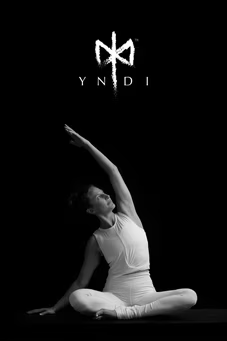

Support for PBS provided by:
Funding for ANTIQUES ROADSHOW is provided by Ancestry and American Cruise Lines. Additional funding is provided by public television viewers.


